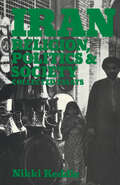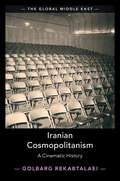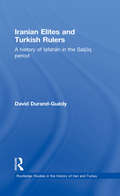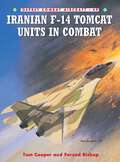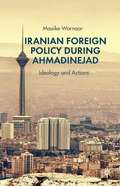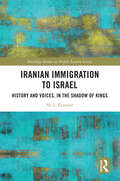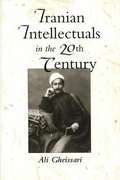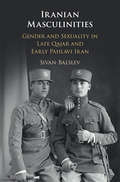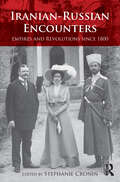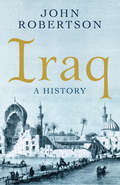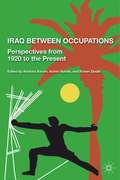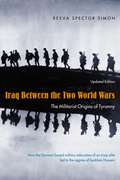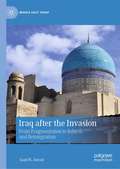- Table View
- List View
Iran: Politics, History and Literature (Iranian Studies)
by Homa KatouzianThis book offers a view of Iran through politics, history and literature, showing how the three angles combine. Iran, being a revolutionary society, experienced two great revolutions within the short span of just seventy years, from the 1900s to the 1970s. Both were massive revolts of the society against the state; the main objective of the first being to establish lawful government to make modernisation possible, and the second, to overthrow the absolute and arbitrary state, though this time mainly under the banner of religion and Marxism-Leninism and anti-Westernism. Neither of them succeeded in their lofty ideals for reasons that are explained and analysed within. The author also offers a detailed description of Iran’s short-term society, examining the political and intellectual lives of two of the most remarkable intellectuals-cum-politicians of the twentieth century. This book provides an overview of modern Persian literature, both poetry and prose, and discusses the works of three of the most remarkable Persian poets and writers of the period. It considers classical Persian literature through the great variety of its form and substance, and neo-classical literary developments in the nineteenth century, covering the whole history of Persian literature. This is crowned in the last chapter by the love poetry of one of the greatest Persian poets. Iran will be of interest to students and scholars of Iranian studies and Middle East Politics.
Iran: Religion, Politics and Society: Collected Essays
by Nikki R. KeddieFirst Published in 1983. Routledge is an imprint of Taylor & Francis, an informa company.
Irandam Ulagappor
by Pa. RaghavanA summary of events that led to the Second World War, the war that shook the entire world and the devastations it caused to the mankind, the role of Hitler in sustaining the war is well written and presents a fair protrayal in this book.
Irangeles: Iranians in Los Angeles
by Jonathan Friedlander Ron Kelley Anita ColbyThis title is part of UC Press's Voices Revived program, which commemorates University of California Press’s mission to seek out and cultivate the brightest minds and give them voice, reach, and impact. Drawing on a backlist dating to 1893, Voices Revived makes high-quality, peer-reviewed scholarship accessible once again using print-on-demand technology. This title was originally published in 1993.This title is part of UC Press's Voices Revived program, which commemorates University of California Press’s mission to seek out and cultivate the brightest minds and give them voice, reach, and impact. Drawing on a backlist dating to 1893, Voices Revived</DIV
Iranian Cosmopolitanism: A Cinematic History (The Global Middle East #3)
by Golbarg RekabtalaeiFrom popular and 'New Wave' pre-revolutionary films of Fereydoon Goleh and Abbas Kiarostami to post-revolutionary films of Mohsen Makhmalbaf, the Iranian cinema has produced a range of films and directors that have garnered international fame and earned a global following. Golbarg Rekabtalaei takes a unique look at Iranian cosmopolitanism and how it transformed in the Iranian imagination through the cinematic lens. By examining the development of Iranian cinema from the early twentieth century to the revolution, Rekabtalaei locates discussions of modernity in Iranian cinema as rooted within local experiences, rather than being primarily concerned with Western ideals or industrialisation. Her research further illustrates how the ethnic, linguistic, and religious diversity of Iran's citizenry shaped a heterogeneous culture and a cosmopolitan cinema that was part and parcel of Iran's experience of modernity. In turn, this cosmopolitanism fed into an assertion of sovereignty and national identity in a modernising Iran in the decades leading up to the revolution.
Iranian Elites and Turkish Rulers: A History of Isfahan in the Saljuq Period (Routledge Studies in the History of Iran and Turkey)
by David Durand-GuedyThe Saljuq period of the eleventh and twelfth centuries saw the arrival in Iran of Türkmen nomads from Central Asia and the beginning of Turkish rule. Through the example of the city of Isfahan, the book analyses the internal evolution of Iranian society in this period and the interaction of the Iranian elites and Turkish rulers. Drawing on an analysis of a wide range of sources, including poetic and epistolary material, this study fills an historiographical gap and casts new light on the two centuries prior to the Mongol invasion. This comprehensive analytical study provides a new contribution to the understanding of many crucial issues: the cultural divide between Western and Eastern Iran; the military potential of city-dwellers; the attitude of the Turkish rulers toward cities and city life; the action of the famous vizier Nizam al-Mulk; the meaning of the Ismaili uprising; and above all the structure of the local elite, organized into rival networks and largely autonomous vis-à-vis state powers. The study is enhanced by a variety of additional features, including extensive genealogical tables, Arabic script and maps. Providing a new understanding of the cultural identity of Iran, this book is an important contribution to the study of the history of Iran and the Medieval period.
Iranian F-14 Tomcat Units in Combat
by Chris Davey Tom CooperSo formidable an opponent did the Iraqi airforce consider the F-14 that during the Iran-Iraq War (1980-1988), they ordered their pilots not to engage F-14s and the presence of one in an area was usually enough to empty it of Iraqi aircraft. Officially losses where tiny; only one F-14 was lost in aerial combat (to a MiG-21), one to a control problem and one downed by a ground-to-air missile. This book looks at the F-14's Iranian combat history and includes first hand accounts from the pilots themselves. It will consider key engagements and the central figures involved, illustrating the realities, successes and failures of the Iranian air campaign.
Iranian F-4 Phantom II Units in Combat
by Jim Laurier Farzad BishopDifferent versions of the jet have provided the backbone of the frontline strength of the Iranian air force since the 1970s, and whole generations of Iranian pilots and ground personnel have been trained to fly and maintain them. Indeed, the type bore the brunt of active combat operations during the long war with Iraq. Iranian F-4 Phantom IIs were also some of best equipped examples ever exported by the USA. Some Iranian Phantom II pilots gathered immense experience on the type, flying it in combat for more than ten years. This book removes the veil of secrecy surrounding Iranian Phantom II operations since the Iran-Iraq War (1980-1988).
Iranian Foreign Policy During Ahmadinejad
by Maaike WarnaarWritten for scholars and practitioners puzzled by Iran's foreign policy choices, this book argues that Iran's foreign policy behavior is best understood in the context of the regime's foreign policy ideology, which is rooted in a conception of Iran as a nation changed by the 1979 Revolution and an example to other nations in a changing world.
Iranian History and Politics: The Dialectic of State and Society (Routledge/BIPS Persian Studies Series)
by Homa KatouzianThis book contains the most detailed and comprehensive statement of Homa Katouzian's theory of arbitrary state and society in Iran, and its applications to Iranian history and politics, both modern and traditional. Every chapter is a study of its own specific topics while being firmly a part of the whole argument. The discussions include close comparisons with the history of Europe to demonstrate the diversities of the logic and sociology of Iranian history from their European counterparts. Being the first modern theory of Iranian history, it is highly regarded by Iranian historians and social scientists, especially as it has helped to resolve many of the anomalies resulting from the application of traditional theories.
Iranian Immigration to Israel: History and Voices, in the Shadow of Kings (Routledge Studies in Middle Eastern Society)
by Ali L. EzzatyarExploring the fascinating history behind Iranian-Jewish immigration to Israel, this book offers a rare and untold history of one of Israel’s Middle Eastern Jewish populations. Over the twentieth century, thousands among Iran’s Jewish community left their ancestral homes and immigrated to the Jewish State, while thousands remained in Iran, even after the birth of the Islamic Republic of Iran. Using first-hand narratives, the evolution of Zionist activities and recruitment in Iran over the last century is covered, alongside an Iranian-Jewish population that, unlike other Middle Eastern Jewish communities, did not ultimately arrive in the Holy Land as a majority of their community. For those that did arrive (or, make aliyah) the Israeli nation-building process had unique ramifications. The integrative process and current status of the Iranian community in Israel is also examined, providing an intimate picture of Iranian life in Israel, nearly 75 years after Israel’s establishment. A natural addition to any collection on Jewish or Israeli history, and essential reading for a full understanding of Iran-Israel relations, students of Israeli nation-building and affairs, as well as Iranian history, demographics, and politics will find this book invaluable.
Iranian Intellectuals in the 20th Century
by Ali GheissariSince the middle of the nineteenth century, Iranian intellectuals have been preoccupied by issues of political and social reform, Iran's relation with the modern West, and autocracy, or arbitrary rule. Drawing from a close reading of a broad array of primary sources, this book offers a thematic account of the Iranian intelligentsia from the Constitutional movement of 1905 to the post-1979 revolution. Ali Gheissari shows how in Iran, as in many other countries, intellectuals have been the prime mediators between the forces of tradition and modernity and have contributed significantly to the formation of the modern Iranian self image. His analysis of intellectuals' response to a number of fundamental questions, such as nationalism, identity, and the relation between Islam and modern politics, sheds new light on the factors that led to the Iranian Revolution--the twentieth century's first major departure from Western political ideals--and helps explain the complexities surrounding the reception of Western ideologies in the Middle East.
Iranian Masculinities: Gender and Sexuality in Late Qajar and Early Pahlavi Iran
by Sivan BalslevThe transition from Qajar rule in Iran (c.1789–1925) to that of rule by the Pahlavi dynasty (1925–1979) set in motion a number of shifts in the political, social, and cultural realms. Focusing on masculinity in Iran, this book interweaves ideas and perceptions, laws, political movements, and men's practices to spotlight the role men as gendered subjects played in Iranian history. It shows how men under the reign of Reza Shah dressed, acted, spoke, and thought differently from their late Qajar period counterparts. Furthermore, it highlights how the notion of being a "proper Iranian man" changed over these decades. Demonstrating how an emerging elite of western-educated men constructed and promoted a new model of masculinity as part of their struggle for political, social, and cultural hegemony, Balslev shows how this new model reflects wider developments in Iranian society at the time including the rise of Iranian nationalism and the country's modernisation process.
Iranian Media: The Paradox of Modernity (Routledge Advances in Internationalizing Media Studies)
by Gholam KhiabanyThe post-revolutionary state in Iran has tried to amalgamate ‘Sharia with electricity’ and modernity with what it considers as ‘Islam’. While sympathetic to private capital, through quasi anti-capitalist politics, the state began to restrict market-relations, confiscate major assets of sections of the Iranian bourgeoisie, and nationalize major aspects of Iran’s industry, including its communications system. Since the end of war with Iraq and the start of the process of ‘reconstruction’, market-driven development and economic policies have been key aims of the state.
Iranian Music and Popular Entertainment: From Motrebi to Losanjelesi and Beyond (Iranian Studies)
by Sasan Fatemi Gj BreyleyThe word motreb finds its roots in the Arabic verb taraba, meaning 'to make happy.' Originally denoting all musicians in Iran, motrebi came to be associated, pejoratively, with the cheerful vulgarity of the lowbrow entertainer. In Iranian Music and Popular Entertainment, GJ Breyley and Sasan Fatemi examine the historically overlooked motrebi milieu, with its marginalized characters, from luti to gardan koloft and mashti, as well as the tenacity of motreb who continued their careers against all odds. They then turn to losanjelesi, the most pervasive form of Iranian popular music that developed as motrebi declined, and related musical forms in Iran and its diasporic popular cultural centre, Los Angeles. For the first time in English, the book makes available musical transcriptions, analysis and lyrics that illustrate the complexities of this history. As it presents the findings of the authors' years of ethnographic work with the history's protagonists, from senior motreb to pop-rock stars, the book reveals parallels between the decline of motrebi and the rise of 'modernity.' In the twentieth century, the fate of Tehran's motrebi music was shaped by the social and urban polarization that ensued from the modern market economy, and losanjelesi would be similarly affected by transnational relations, revolution, war and migration. Through its detailed and informed examination of Iranian popular music, this study reveals much about the values and anxieties of Iranian society, and is a valuable resource for students and scholars of Iranian society and history.
Iranian-Russian Encounters: Empires and Revolutions since 1800 (Iranian Studies)
by Stephanie CroninOver the past two hundred years, encounters between Iran and Russia have been both rich and complex. This book explores the myriad dimensions of the Iranian-Russian encounter during a dramatic period which saw both Iran and Russia subject to revolutionary upheavals and transformed from multinational dynastic empires typical of the nineteenth century to modernizing, authoritarian states typical of the twentieth. The collection provides a fresh perspective on traditional preoccupations of international relations: wars and diplomacy, the hostility of opposing nationalisms, the Russian imperial menace in the nineteenth century and the Soviet threat in the twentieth. Going beyond the traditional, this book examines subaltern as well as elite relations and combines a cultural, social and intellectual dimension with the political and diplomatic. In doing so the book seeks to construct a new discourse which contests the notion of an implacable enmity between Iran and Russia Bringing together leading scholars in the field, this book demonstrates extensive use of family archives, Iranian, Russian and Caucasian travelogues and memoirs, and newly available archives in both Iran and the countries of the former Soviet Union. Providing essential background to current international tensions, this book will be of particular use to students and scholars with an interest in the Middle East and Russia.
Iran’s Foreign Policy After the Nuclear Agreement: Politics Of Normalizers And Traditionalists (Middle East Today Series)
by Farhad RezaeiThe book offers the first systematic account of Iran’s foreign policy following the nuclear agreement (JCPOA) of July 14, 2015. The author evaluates in what ways the JCPOA, in conjunction with the dramatic changes taking shape in the international order, have affected Iran’s foreign policy. Known as Normalizers, the moderate leadership under President Hassan Rouhani had planned to normalize Iran’s foreign relations by curtailing terrorism and reintegrate Iran into the community of nations. Their hardline opponents, the Principalists, rejected the JCPOA as a tool of subjection to the West and insisted on exporting the Islamist revolution, a source of much destabilization and terror in the region and beyond. The project also analyzes the struggle between Normalizers and their hardline opponents with regards to global and regional issues and Iran’s foreign policy towards global powers including the U.S., Russia, EU, and regional countries including Iraq, Syria, Israel, Saudi Arabia and Turkey.
Iran’s Nuclear Program and the Global South: The Foreign Policy Of India, Brazil, And South Africa
by Michal OndercoThis book studies the reactions of India, Brazil, and South Africa the three main non-proliferation actors of the Global South to Iran's nuclear program. Their responses are explained and situated in wider foreign policy context.
Iraq
by Bill ThompsonIn the spring of 2003, the United States and it allies invaded Iraq to remove one of the world's most brutal dictators, Saddam Hussein, from power. But when the Hussein regime fell, Iraqis wondered whether their country would hold together, or if it would disintegrate under the force of long-standing ethnic and religious rivalries. The international community also watched closely. With the world's second-largest proven oil reserves, Iraq holds great economic importance for an energy-hungry globe. As one of the largest Arab states, Iraq is politically important in the Middle East region as well. Some American policymakers believed that with Saddam gone, Iraq could become an example of democracy and progress for the other Arab states. However, a period of sectarian violence prevented that from the occurring. Despite the conflict, Iraqis took steps toward developing a parliamentary democracy, approving a constitution in October 2005 and holding several subsequent elections for government officials. In addition, new military strategies have significantly reduced the level of violence. While the future remains uncertain, Iraqis hope their country is on a path to peace and promise. Discusses the geography, history, economy, government, religion, people, foreign relations, and major cities of Iraq.
Iraq
by John RobertsonIn this insightful analysis, highly-respected expert John Robertson canvases the entirety of Iraq's rich history, from the seminal advances of its Neolithic inhabitants to the aftermath of the American-led invasion and Iraq today. Grounded in extensive research, this balanced account of a country and its people explores the greatness and grandeur of Iraq's achievements, the brutality and magnificence of its ancient empires, its contributions to the emergence of the world's enduring monotheistic faiths, and the role the great Arab caliphs of Baghdad played in the medieval cultural flowering that contributed so much to the European Renaissance and the eventual rise of the West.Fascinating and thought-provoking, Robertson's work sheds light on a remarkable story of world history, one that has been too often overlooked. Wide-ranging and extensive in approach, it is sure to be greatly appreciated by historians, students and all those with an interest in this diverse and enigmatic country.
Iraq
by Mohamed El-ShibinyIraq: A Lost War deals with the impact of September 11th on the occupation of Iraq and the U. S. declaration of war on international terrorism. It investigates whether war in Iraq was morally justified and whether coalition forces capturing and hanging its president were morally and legally acceptable internationally.
Iraq Between Occupations
by Achim Rohde Amatzia Baram Ronen ZeidelThis edited volume represents a re-examination of the most central issues in the history of the Iraqi nation state until the American occupation (1920-2003) and, in the light of that history, a re-evaluation of developments under the occupation (2003-2008).
Iraq Between the Two World Wars: The Militarist Origins of Tyranny
by Reeva Spector SimonWhy did a group from the Iraqi army seize control of the government and wage a disastrous war against Great Britain, rejecting British and liberal values for those of a militaristic Germany? What impact did these actions have on the thirty-year regime of Saddam Hussein?Departing from previous studies explaining modern Iraqi history in terms of class theory, Reeva Simon shows that cultural and ideological factors played an equal, if not more important, role in shaping events. In 1921 the British created Iraq, and an entourage of ex-Ottoman army officers, the Sharifians, became the new ruling elite. Simon contends that this elite, returning to an Iraq made up of different ethnic, religious, and social groups, had to weld these disparate elements into a nation. Pan-Arabism was to be the new ideological source of unity and loyalty. Schools and the army became the means through which to implant it, and a series of military coups gave the officers the chance to act in its name. The result was an abortive revolt against Britain in 1941. And the legacy of the revolt is still apparent in the next two generations of Iraqi officers that led to the regime of Saddam Hussein.This updated edition locates the sources of Iraqi nationalism in the experience of these ex-Ottoman army officers who used the emergent pan-Arabism to weld a disparate population into a nation. Simon shows that the relationships forged between Iraqi officers and Germans in Istanbul before WWI left deep legacies that go a long way toward explaining the disastrous war against Great Britain in 1941, the rejection of liberal values, the revolution of 1958 in which the military finally seized power, and the outlook of the leadership recently overthrown by American and British armies.
Iraq Full Circle
by Darron WrightCol. Wright served three tours of duty in the Iraq War, commanding the last active combat brigade to withdraw from Operation Iraqi Freedom. His book personalizes the broader operational conflict we've all heard so much about, giving us a previously unknown insider command perspective that will fundamentally change how our nation thinks of the war. For Col Wright, the Iraq war was a good war fought well. In his new book, Iraq Full Circle, he offers a first-hand assessment of the US Army's eight year war in Iraq.As battalion operations officer for an infantry battalion from 2003-2004 operating in the dangerous and volatile Sunni Triangle, followed by a tour of duty as a Brigade Executive Officer from 2005-2006 in Baghdad, Wright witnessed some of the harshest fighting seen during the war. He saw the evolution from 'shock and awe' to the 'clear-hold-build' strategy during the height of sectarian violence and was on-hand for the transition to COIN followed by the handover of security operations to the Iraqi Security Forces. In August 2010, Wright, as a deputy brigade commander, was among the last combat soldiers to leave Iraq as part of President Obama's draw-down of troops.While Wright does not hesitate to criticize the political and military leadership that failed to foresee the insurgency, or the errors in judgment that led to the dismantling of the Iraqi Army in 2003, his overall assessment of the war is that the US Army achieved what it was asked to do by two Presidents. Calling upon his experience--and the examination of thousands of after action reports, combat operations orders, and over 100 interviews--Wright pieces together a compelling and cohesive narrative of the war. Readers will be surprised to learn:· Wright had a strong hunch beginning in September 2001 that he would be deployed to Iraq; he and his fellow Army leaders began preparing for an invasion soon after the 9/11 attacks.· Army leaders were already implementing much of the COIN doctrine in 2004 and 2005, well before the official change in doctrine and the publication of the new field manual on COIN.· For Wright and most other leaders at his level, President Bush's troop "surge" in November 2006 was completely uncontroversial and utterly inevitable. They knew that clear-hold-build was the right strategy and would work but that they did not have enough troops to make it stick.In his closing chapters, Wright discusses the growth and evolution of the Iraqi Security Forces, from an abjectly corrupt and militarily useless cohort in 2004 to a well-trained and stable entity capable of securing Iraq and providing for (mostly) safe and open national elections in 2010. He finishes his narrative with his thoughts on the future of Iraq, understanding that sectarian divisions persist, but that the Iraqi Security Forces have been well-trained by the US Army to secure Iraq's future.From the Hardcover edition.
Iraq after the Invasion: From Fragmentation to Rebirth and Reintegration (Middle East Today)
by Saad N. JawadThis book states that one calamitous result of the invasion and occupation of Iraq (2003) was the dismantling of the state and the destruction of all the structures and processes of government. The invading powers, the USA and UK, were obsessed with the removal of the regime of Saddam Hussein, which they regarded a clear danger and a serious threat to their strategies designs and in the region. To justify their atrocity, they trumped up a number of falsehoods and charges, such as the issue of WMD. Before that and over a period of 13 years, they had imposed unprecedented, fierce and relentless sanctions on the country. These sanctions not only impoverished and aggrieved the people of Iraq, but also instilled and deeply etched a sense of pessimistic impassivity among many Iraqis in that they felt no longer cared whatever the future might hold for them. The regime’s totalitarian nature also helped in creating this attitude. To add insult to injury, the provisional US-installed administration passed many resolutions which have had catastrophic consequences, such as the total dissolution of the security and armed forces and the de-baathification law. The hurriedly contrived new constitution confounded the situation even further and negatively impacted the integrity of the state. Exploiting the inconclusiveness and ambiguities contained in it, the Iraqi Kurdish Region became a de facto independent entity. In time, the central government became weaker than the regions. The hardest hit in this chaotic state of affairs was national unity. The sectarian and ethnic quota-based policies followed by the occupying forces and the expatriate Iraqis who came along with them dealt successive blows to the laws and institutions of the land which further disintegrated the Iraqi state. Iraq now is in dire need of national reconciliation programme aimed at re-uniting the people and the country.

